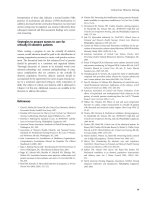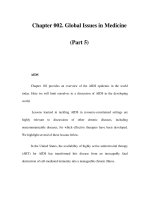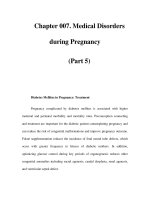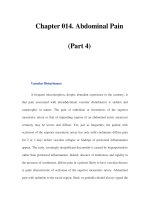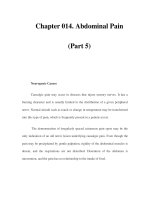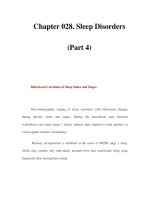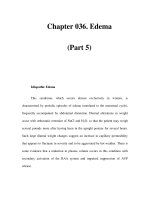Chapter 042. Gastrointestinal Bleeding (Part 5) ppsx
Bạn đang xem bản rút gọn của tài liệu. Xem và tải ngay bản đầy đủ của tài liệu tại đây (50.87 KB, 7 trang )
Chapter 042. Gastrointestinal
Bleeding
(Part 5)
LOWER GIB
(Fig. 42-2) Patients with hematochezia and hemodynamic instability should
have upper endoscopy to rule out an upper GI source before evaluation of the
lower GI tract. Patients with presumed LGIB may undergo early sigmoidoscopy
for the detection of obvious, low-lying lesions. However, the procedure is difficult
with brisk bleeding, and it is usually not possible to identify the area of bleeding.
Sigmoidoscopy is useful primarily in patients <40 years with minor bleeding.
Figure 42-2
Suggested algorithm for patients with acute lower gastrointestinal
bleeding. Sequential recommendations under "Hemodynamic instability" assume
a test is found to be nondiagnostic before next test is performed.
*
Some suggest
colonoscopy for any degree of rectal bleeding in patients <40 years as well. †If
massive bleeding does not allow time for colonic lavage, proceed to angiography.
Tc-RBC,
99m
technetium-labeled red blood cell.
Colonoscopy after an oral lavage solution is the procedure of choice in
patients admitted with LGIB unless bleeding is too massive or unless
sigmoidoscopy has disclosed an obvious actively bleeding lesion.
99m
Tc-labeled
red cell scan allows repeated imaging for up to 24 h and may identify the general
location of bleeding. However, radionuclide scans should be interpreted with
caution because results, especially from later images, are highly variable. In active
LGIB, angiography can detect the site of bleeding (extravasation of contrast into
the gut) and permits treatment with intraarterial infusion of vasopressin or
embolization. Even after bleeding has stopped, angiography may identify lesions
with abnormal vasculature, such as vascular ectasias or tumors.
GIB OF OBSCURE ORIGIN
Obscure GIB is defined as persistent or recurrent bleeding for which no
source has been identified by routine endoscopic and contrast x-ray studies; it may
be overt (e.g., melena, hematochezia) or occult. Push enteroscopy, with a specially
designed enteroscope or a pediatric colonoscope to inspect the entire duodenum
and part of the jejunum, is generally the next step. Push enteroscopy may identify
probable bleeding sites in 20–40% of patients with obscure GIB. Video capsule
endoscopy, which allows endoscopic examination of the entire small intestine,
increases diagnostic yield in obscure GIB: a systematic review of 14 trials
comparing push enteroscopy to capsule revealed "clinically significant findings"
in 26% and 56% of patients, respectively. However, lack of control of the capsule
prevents its manipulation and full visualization of the intestine; in addition, tissue
cannot be sampled and therapy cannot be applied. A new endoscopic technique,
double-balloon enteroscopy, allows the endoscopist to potentially examine and
provide therapy to much or all of the small intestine. If enteroscopy and video
capsule endoscopy are negative or unavailable, a specialized radiographic
examination of the small bowel (e.g., enteroclysis) should be performed. Newer
imaging techniques being investigated include CT and MR enterography.
Patients with continued obscure GIB who require transfusions or repeated
hospitalizations warrant further investigations.
99m
Tc-labeled red blood cell
scintigraphy should be employed. Angiography is useful even if bleeding has
subsided, since it may disclose vascular anomalies or tumor vessels.
99m
Tc-
pertechnetate scintigraphy for diagnosis of Meckel's diverticulum should be done,
especially in the evaluation of young patients. When all tests are unrevealing,
intraoperative endoscopy is indicated in patients with severe recurrent or persistent
bleeding requiring repeated transfusions.
OCCULT GIB
Occult GIB is manifested by a positive test for fecal occult blood or iron-
deficiency anemia. Evaluation of a positive test for fecal occult blood generally
should begin with colonoscopy, particularly in patients >40 years. If evaluation of
the colon is negative, many perform upper endoscopy only if iron-deficiency
anemia or upper GI symptoms are present, while others recommend upper
endoscopy in all patients since up to 25–40% of these patients may have some
abnormality noted on upper endoscopy. If standard endoscopic tests are
unrevealing, enteroscopy, video capsule endoscopy, and/or enteroclysis may be
considered in patients with iron-deficiency anemia.
Further Readings
Chan FK et al: Proton pump inhibitor plus a COX-2 inhibitor for the
prevention of recurrent ulcer bleeding in patients with arthritis: A double blinded,
randomized trial. Gastroenterology 130:A-105, 2006
Cipolletta L et al: Outpatient management for low-risk nonvariceal upper
GI bleeding: A randomized controlled trial. Gastrointest Endosc 55:1, 2002
[PMID: 11756905]
Conrad SA et al: Randomized, double-blind comparison of immediate-
release omeprazole oral suspension versus intravenous cimetidine for the
prevention of upper gastrointestinal bleeding in critically ill patients. Crit Care
Med 33:760, 2005 [PMID: 15818102]
D'Amico G et al: Pharmacological treatment of portal hypertension: An
evidence-based approach. Semin Liver Dis 19:475, 1999 [PMID: 10643630]
Henderson JM et al: Distal splenorenal shunt versus transjugular
intrahepatic portal systematic shunt for variceal bleeding: A randomized trial.
Gastroenterology 130:1643, 2006 [PMID: 16697728]
Laine L, Cook D: Endoscopic ligation compared with sclerotherapy for
treatment of esophageal variceal bleeding: A meta-analysis. Ann Intern Med
123:280, 1995 [PMID: 7611595]
Lau JYW et al: Effect of intravenous omeprazole on recurrent bleeding
after endoscopic treatment of bleeding peptic ulcers. N Engl J Med 343:310, 2000
[PMID: 10922420]
Marmo R et al: Dual therapy versus monotherapy in endoscopic treatment
of high-risk bleeding ulcers: A meta-analysis of controlled trials. Am J
Gastroenterol 102:279, 2007 [PMID: 17311650]
Rockall TA et al: Risk assessment after acute upper gastrointestinal
haemorrhage. Gut 38:316, 1996 [PMID: 8675081]
Triester SL et al. A meta-analysis of the yield of capsule endoscopy
compared to other diagnostic modalities in patients with obscure gastrointestinal
bleeding. Am J Gastroenterol 100:2407, 2005 [PMID: 16279893]
Bibliography
Cook DJ et al: A comparison of sucralfate and ranitidine for the prevention
of upper gastrointestinal bleeding in patients requiring mechanical ventilation. N
Engl J Med 338:791, 1998 [PMID: 9504939]
